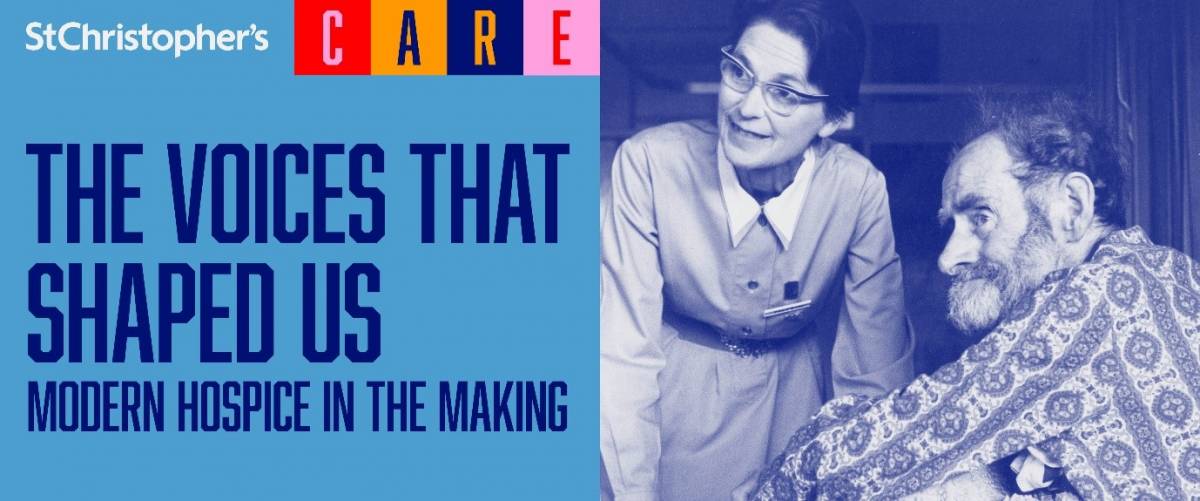Physio manager's memories of 'drilling' team before Queen's visit feature in hospice's exhibition
A former superintendent physiotherapist at a pioneering south London hospice ‘drilled’ members of her team to ensure they had washed their hair and polished their shoes in preparation for a visit by the Queen in 1988.
Betty O’Gorman said the Queen’s visit to St Christopher’s Hospice in Sydenham took place during an event to celebrate its 21st anniversary. Betty, whose reminiscences feature prominently on the hospice’s website, said: ‘I drilled my team that if they were going to wash their hair and have a clean uniform it was that day and not the day after and not the day before.
‘I must have spent twice as long ironing my top and all our shoes were polished and we were all gleaming and it was just amazing. And of course, the buzz that the patients got, put them on a high for days. The fact that the Queen had stopped at their bed or with them in the day centre and they couldn’t quite get over it.’

Chance to hear oral histories
The hospice, which was founded by Dame Cicely Saunders in 1967, is inviting people to visit an interactive oral history exhibition on 17 September. The event forms part of the national Heritage Open Days initiative that happens every September, when the doors of culturally important buildings are opened to the public at large.
Titled A Modern Hospice in the Making, the exhibition includes contributions from 70 professionals, patients, volunteers, and community members who established links with the hospice from the 1960s to the present day. The Voices that Shaped Us project was supported by the National Lottery Heritage Fund and focuses on ‘preserving precious memories that risk being lost in time’.
Visitors will have opportunities to ‘learn about death, dying and loss and see how medicine, palliative care and general attitudes to end of life have developed and changed within hospices and society as a whole’.
Pretty well straight away I felt in ward rounds and discussing with doctors, everybody was very open to suggestions. This sense of non-hierarchical working which I always think is so powerful at St Christopher’s [physio Jenny Taylor]
Jenny Taylor, a former senior physiotherapist, recalls being struck by the absence of a hierarchy at the hospice
‘Pretty well straight away I felt in ward rounds and discussing with doctors, everybody was very open to suggestions. This sense of non-hierarchical working which I always think is so powerful at St Christopher’s.
‘The feeling that everybody mattered in the team. So, you could start to express opinions and views and wonder out loud if certain things could be done to enhance life more.'
The elephant in the car park
Welfare office Laura Bechelet's recollection is typical pf the hospice's willingness to break new ground: ‘One time we had somebody from a large circus family and we had an elephant in the car park come and see him.'
Jenny Taylor on encouraging patients to try physiotherapy
‘People would come to the Day Centre for example and have a day of activity: creative therapies, see the hairdresser, relaxation, a lovely lunch and talking to people, social workers, counselling. And then as part of their sessions we might say do you want to come and look at physiotherapy? ‘Some would come along and just happen to notice it and say that looks really interesting, some would be referred very specifically,' Jenny recalls.
‘But always when they came through, we would then work on helping mobility and strength, function, balance that side of things. And then we would encourage family members, if they were around, to perhaps come and sit with us.’
Through its educational and research arms, St Christopher’s works with people across the world to improve and develop hospice care. More than 1,300 people are usually under its care at any one time, and it provided care and support to more than 5,000 patients and 2,000 families and carers across south London, at home, in the community and in the hospice in 2021. There are more than 500 staff and members and more than 1,000 ‘amazing’ volunteers.
The ‘Brompton Cocktail’
Founder Cicely Saunders championed better care for dying people by talking about her holistic idea of ‘total pain’, in which pain has physical, psychological, social and spiritual components.
As the hospice was established outside the NHS, it had greater freedom to innovate. For example, in the 1970s, researcher Robert Twycross conducted trials of cancer pain medication. Previously, many terminal cancer patients received the ‘Brompton Cocktail’, a mixture of drugs containing morphine, syrup, gin, cannabis and cocaine. Dr Twycross’s research proved morphine could be given as pain relief on its own without worrying that patients would become addicted.
The Voices That Shaped Us: A Modern Hospice in the Making is open from 11am- 4pm on 17 September. Entry is free. St Christopher’s CARE is at 51-59 Lawrie Park Road, London SE26 6DZ
For more information, visit: https://www.stchristophers.org.uk/voices
To find out more about St Christopher’s Hospice, visit: www.stchristophers.org.uk
Twitter: @StChrisHospice
Author: Ian A McMillan













